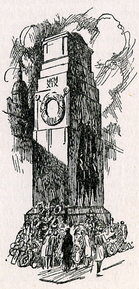Originally distributed as HVM Society Snippet – No.159
The first flower to regrow in soil disturbed by battle is the red corn poppy. This was initially remarked upon during the Napoleonic wars. Later, following the First World War, these bright little flowers were again the first to be seen as the torn, bare earth of no man’s land slowly began to transform back into pasture which, to this day, still carries the deep scars of combat. In 1921 the poppy was adopted as a symbol to commemorate soldiers who have died in war.
In his 1926 “The London Year”, a mere eight years after the end of the Great War, HV Morton described, in moving tones, the Armistice Day ceremony taking place around the newly erected Cenotaph, and the two minute silence that followed the laying of the wreaths:
Now London is hushed. The roar from Charing Cross dies away. Only the jingle of a horse’s bit breaks the silence of a people frozen in memory. Three white gulls fly over from the Thames, circle above the Cenotaph, and go. In Whitehall you feel the silence and the prayer ; for men and women are praying. It is not right to look. It is too sacred. The old memories well up in the heart, the old aches, the great joys, the misery, the gallantry, the laughter, and the tears.
How long two minutes can be! How much can be remembered! How little can a few years touch those things that go right down into the heart. I would not dare to look into a woman’s mind at this time—those women with medals! I would not care to imagine their thoughts ; but the young men— ah! in two minutes how many voices call to us, how many faces we remember, how many friendships, how many are the splendid loyalties of those “unhappy far-off times….”
Today, Monday 11th November is Remembrance Day, marking the 95th anniversary of the end of the First World War. The wearing of the poppy, or the laying of a wreath, on this day has nothing to do with politics, or with glorification and everything to do with gratitude, honour and respect and the determined hope that by remembering the past with all its horrors, we can perhaps be spared a repetition of it. The poppy is the ultimate peace symbol, pure and simple.
Niall Taylor, Glastonbury, Somerset, England
11 November 2013






